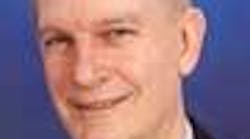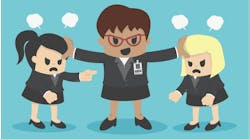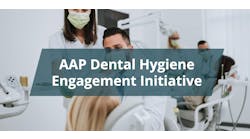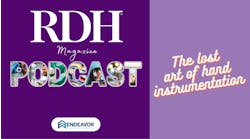By Ann-Marie C. DePalma, RDH, MEd, FAADH
When a continuing-education presenter begins to talk about microbiology, usually the eyes in the audience begin to glaze over and heads nod off. However, Bill Landers has created a microbiology course that is not only informative, but fun! Bill’s program, titled “Traditional vs. Microbiological Risk Assessment,” is designed to help hygienists realize that most clinical hygiene techniques were developed in the 1900s to treat gross symptoms of periodontal disease. These techniques are not appropriate for treating the communicable infections that we now know are periodontal disease. The program allows hygienists to learn about new diagnostic technologies and anti-infective treatment therapies that can help assess periodontal risk earlier and treat it more effectively. Imagine all of this while having a great time learning the heavy science! The program offers a win-win situation for both the patient and the dental professional.
Bill believes that early diagnostics for periodontal disease such as disclosing solutions, the reliance of bleeding on probing, and pocket depths are not predictive of future attachment loss. Disclosing solution only discloses supragingival plaque, which is aerobic and nonpathogenic; bleeding on probing measures capillary fragility rather than indicates disease; and pocket depths and radiographs can only detect bone loss after the fact. Dentistry should no longer rely on these “disease markers” since microbiological tests are now readily available. Bill’s course includes an introduction to these new tests and how the dental hygienist can incorporate them into total patient care. These tests include:
- BioScan phase contrast video microscopy – can detect a high number of high-risk bacterial morphotypes (spirochetes and motile cells). It can detect high levels of WBCs, which are a hallmark of periodontal inflammation.
- BANA test – highly sensitive test and specific enzymatic assay for P. gingivalis, T. forsythus, and T. denticola, the bacteria most highly associated with periodontal diseases.
- Anaerobic cultures – gold standard for microbial testing: eight to 10 common periodontal pathogens can be determined via a paper point sample.
- DNA tests – periodontal pathogens can be detected with recombinant DNA techniques.
All of these tests are designed to allow the dental professional to “treat” the periodontal disease, not just its sequella.
Many patients are unaware of the role that hygienists play in the health-care system. Many see hygienists as the “cleaning lady.” Many hygienists feel that they are just “scrapodontists,” since that is what has been taught over the years with frustrating results. Bill teaches that scaling plays a role but that there needs to be a more effective and rewarding paradigm shift in treatment. A microbiologically sensible approach that treats the infection rather than the symptoms produces far better results than ever possible for both the patient and the hygienist. With the increasing research involving the periodontal-systemic connection, this approach enables the dental hygienist to become an integral part of the health-care system.
Bill uses PowerPoint extensively in his program. A four-hour program typically contains hundreds of “build-up slides” with pictures and animations. These help the audience understand often complex discussions. Rather than waste tons of paper for handouts, Bill has been experimenting with having the entire presentation on CD so that attendees can refer back at their own pace and time. Additionally, by having a CD presentation, participants can return to their practices and have other team members view the materials to incorporate a total team approach to office care. Bill’s goal is to make sterile science understandable and interesting. Many have commented on his abilities as an engaging speaker who is passionate about his subject and can take “boring” science and make it fun!
Bill never considered dentistry until he was in the United States Air Force serving as a dental corpsman in the late 1960s. There he was “trained” as an assistant and hygienist. He became the chief hygienist in the periodontology department and worked in oral surgery and the hospital’s OR. He even considered going to dental school after the service and majored in microbiology, but quit school six hours short of the degree! He worked for a number of dental and continuing-education companies until he met Dr. Paul Keyes and Dr. Thomas Rams. Their friendship changed Bill’s life and refocused his interest on microbiology. It was their mentoring that rekindled his love for science and scientific literature, and they invited him to speak as part of their lectures. Drs. Keyes, Rams, and Max Listgarten impacted his way of thinking in regard to microbiology and the oral environment.
In 1985, Bill was president of Dental Scientific Systems (DSS) when it was acquired by OraTec. DSS was established in 1980 to provide support to dentists who wanted to incorporate “microscopically modulated periodontal therapy” (MMPT) into their periodontal practices as it was practiced by Dr. Keyes, who was at the National Institutes of Dental Research (a part of NIH). As dentists began practicing MMPT, they realized that they needed more than just a microscope to provide complete periodontal care. Initially, OraTec began providing OraChlor, which was the same antimicrobial agent used by Dr. Keyes at NIDR. As dentists wanted more antimicrobial and diagnostic products, OraTec expanded its line to include Viajet irrigator, TheraSol antimicrobial solution, BANA enzymatic tests, BioScan microscopy, along with several other anti-infective products and educational materials. Currently, Bill is the president of OraTec.
Bill is passionate about science and truth. Learning how to read scientific literature has affected almost everything in his life, and he wants to impart that knowledge to others. The truth is a very elusive thing and can be easily bent; finding it amid all of the self-interests and spin requires effort that most are not aware of or unsure of how to accomplish. In his earlier years, he was passionate about fencing and was one of the top ranked epeeists in the country, having had the honor of representing the United States in international competition. Outside of dentistry and the company, he is an avid online gamer, with a “secret life” as a battler of the forces of evil! He has a talent for teaching and enjoys helping others understand often complex ideas.
Although not a hygienist legally, Bill is considered an “honorary” hygienist by those in the profession. He is concerned about the manpower issues facing hygiene and the fact that hygiene programs tend to produce technicians rather than thinkers. He believes that one can always learn new techniques, but it takes a professional to learn how to think and analyze problems.
Bill believes in Thomas Edison’s philosophy, “There’s a better way to do it. Find it!” Bill has done just that with his programs and in his company. Dental professionals and those who seek our care are all the better for his enlightenment and empowerment.
For more information about Bill, his programs, or OraTec, contact [email protected].
About the Author
Ann-Marie C. DePalma, RDH, MEd, FAADH, is a Fellow of the American Academy of Dental Hygiene, member of ADHA and other professional associations. Ann-Marie presents continuing-education programs for hygienists and dental team members and has written numerous articles on a variety of topics. She can be reached at [email protected].








